SEO for Landscapers [How to Do it Yourself]
![SEO for Landscapers [How to Do it Yourself] SEO for Landscapers [How to Do it Yourself]](https://media.graphassets.com/lZv8LRJvRnKJpLniVIx4)
Mar 3, 2023
 - by Kester Browne
- by Kester BrowneThe landscaping industry is getting tougher every year.
For local landscaping companies to survive, they must find ways to stand out.
So if you googled SEO for landscapers, you know that search engine optimization can help your landscaping company grow.
It is a powerful digital marketing technique that can take your landscaping business to the next level.
In this guide, I'll give you a high-level overview of SEO and how to do SEO for your landscaping business.
But first.
What Is SEO for Landscapers?
SEO for landscapers is search engine optimization specifically for landscaping companies.
It mostly uses landscaping-related keywords for search engine optimization so that potential customers can easily find your website when they search for related terms.
SEO process includes:
Technical SEO.
Competitor analysis
On-page SEO.
Link building.
Monitoring results
How Landscaping SEO Drives Traffic to Your Website
Here is an example of two of your landscaping competitors. One in Maryland and one in Northern Virginia.
One has 8400 visitors a month,

and the other has 8600 visitors to their website.

Notice that they both rank for a high number of keywords.
Keywords are the words that searchers use in search engines to find services they’re looking for.
The more content you have on your site with the right keywords, the more keywords you can rank for and the more search traffic you can get.
If you had that much traffic coming to your website, how many of these leads can you convert into customers?
Think about it.
Now let’s dig into how to do SEO for landscapers.
How to Do SEO for Landscaping Companies

#1. Perform an SEO Audit
An SEO audit will show you where your website stands compared to other landscaping company websites.
The landscaping companies you measure yourself against will be those on the first page of the search results and the companies in the map pack.
Some things you'll want to look for are:
- How much traffic do you get to your website every month?
- Which keywords give you the most traffic?
- Which keywords can you rank for?
- What keywords are people using to find your business?
- How many keywords do you rank for?
- What keywords do other landscaping companies rank for?
- How many keywords do your competitors rank for?
- What pages do they have that you don't have?
- Is your website responsive or mobile-friendly?
- Is your website secure?
- Is your website fast, and does it provides a good user experience?
To get this information on your site and your competitor's websites, you can use a keyword research tool like Ahrefs or a free tool like UberSuggest.
These tools are valuable in SEO and show how your website stacks up against competitors.
Ahrefs, the tool I use, will show you the following:

- Your monthly organic traffic (Organic traffic)
- How many keywords do you rank for (Organic keywords)
- The total amount of backlinks you have
- The strength of your website (DR)
This tool can also help you with keyword research, finding broken links, and doing competitor analysis.
Below is an example of two of your landscaping competitors.
These companies in Maryland and Virginia have 8400 and 8600 visitors a month coming to their websites.
If you had that much traffic coming to your website, how many of these leads can you convert into customers?


Need help increasing your website traffic and getting more customers for your landscaping business?
We can help.

#2. Look for SEO Opportunities
The next step in landscaping SEO is to look for opportunities to increase your SEO performance.
A great amount of opportunities will be on-page SEO related.
On-page SEO is simply improving your website pages and making them better.
Some of these on-page opportunities include:
- Targeting and finding relevant keywords for your business
- Finding high-traffic, low-competition keywords
- Finding content gaps
- Finding opportunities to increase conversion rates on your site
- Discovering opportunities you see but your competitors don't see
1. Targeting and Finding Relevant Keywords
One opportunity you can use to your advantage is finding keywords relevant to your business.
To find relevant keywords, you must do keyword research.
Again, you can use tools like Ahrefs or Ubersuggest for keyword research.
Here is an example.
If you live in Arnold, MD, homeowners could be searching Google for your landscaping services.
According to Ahrefs, the keyword "lawn service Arnold MD" gets approximately 150 searches per month with a keyword difficulty score of 0.
The keyword difficulty score tells us how easy or hard the keyword is to rank for.
If you were to target this keyword, your website could stand a very good chance of appearing on page one.
Even in the top 5 results.
Of course, there are other factors, but I'll keep it simple.
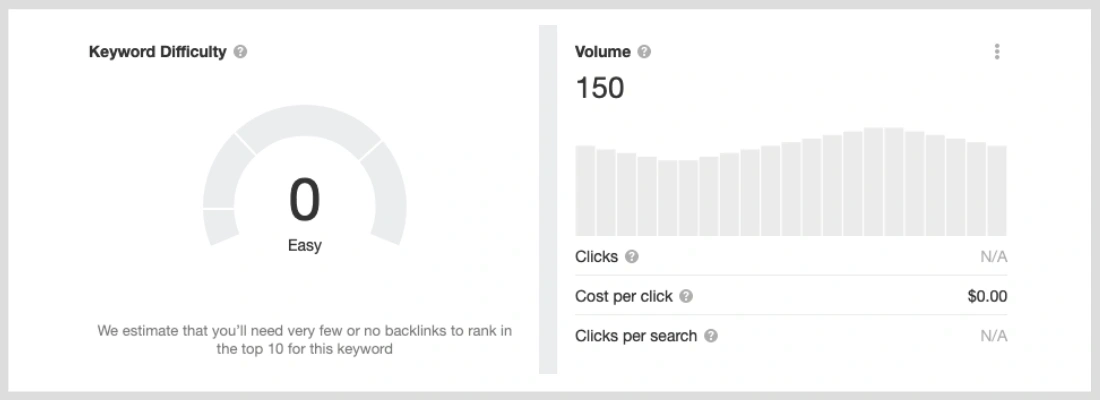
Here's another example.
People living in Annapolis may be looking for a landscaper that offers mulch delivery.
They may use the keywords "mulch delivering Annapolis, MD."
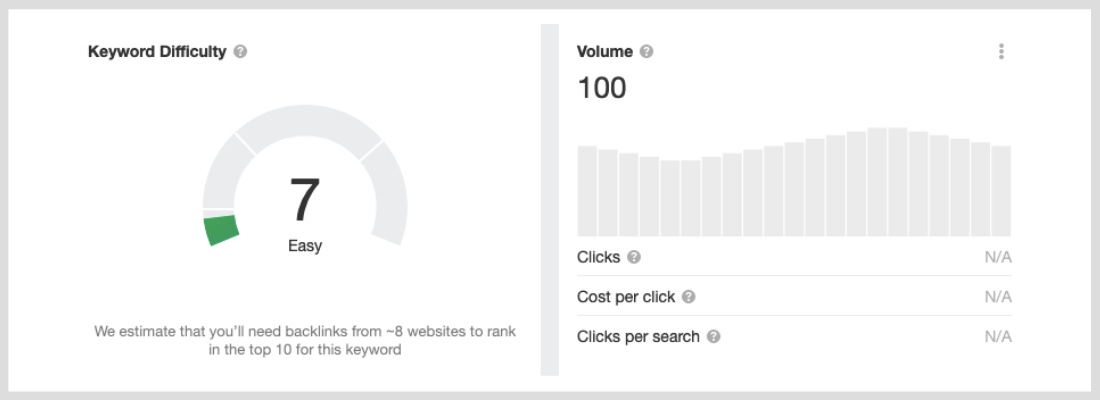
According to Ahrefs, this keyword is also easy to rank for, with a keyword difficulty score of 7 and has a search volume of approximately 100 people per month.
One more example.
If you deliver mulch in Rockville, the keyword "mulch delivering Rockville, MD," is even easier.
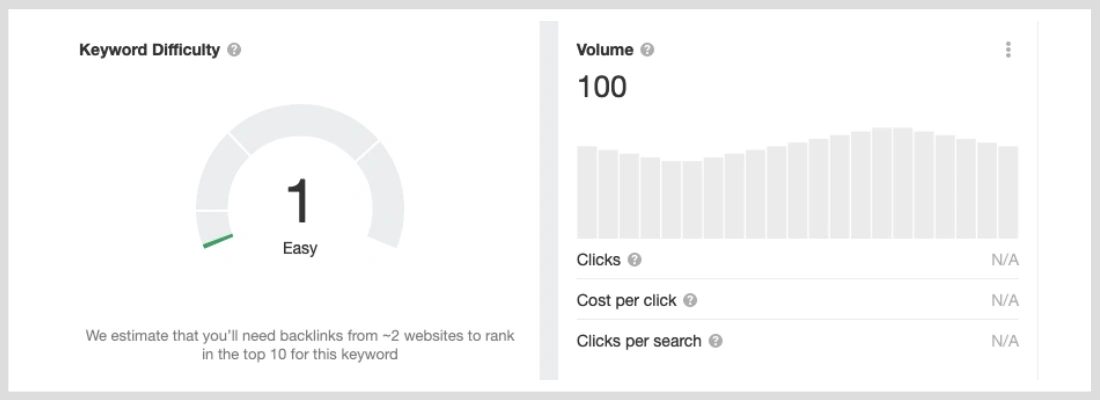
The keyword difficulty is only 1, and it has a monthly search volume of 100 people.
2. Find High Traffic Low Competition Keywords
To find high-traffic, low-competition keywords, you can use several tools.
You can use:
- Ahrefs.
- SEMrush.
- Answer the Public.
- Keywords Everywhere.
- Google Keyword Planner.
You can use Ahrefs to find keywords and keyword variations with high search volumes and low keyword difficulty scores.
Adding keywords with high search volume and low keyword difficulty to your website's content is a great way to get traffic that can become leads and paying customers.
For example, the keyword "bamboo removal" has a difficulty score of 4 and is searched approximately 700 times monthly.

Ahrefs also gives you more keyword ideas.
You can use these keyword ideas to create SEO content for your web pages and blog posts.
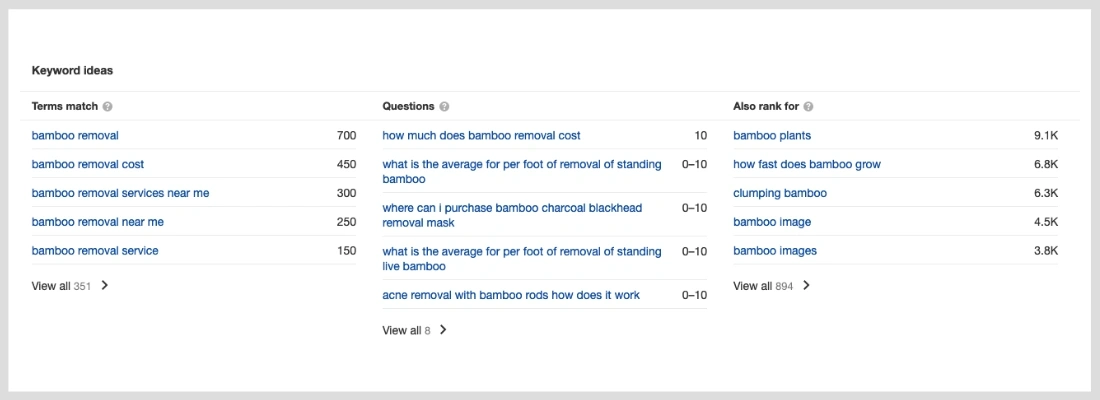
You still need to qualify these keywords to see if you can rank for them.
We'll leave that for another time.
3. Find Content Gaps
Compare your website to your competitors' websites.
When comparing sites, you should use at least the top three landscaping companies on the first page of Google.
Ask yourself these questions:
- What makes their website better than yours?
- What information do they have on their website that your website doesn't have?
- What kind of content do they have?
- Is their content up to date?
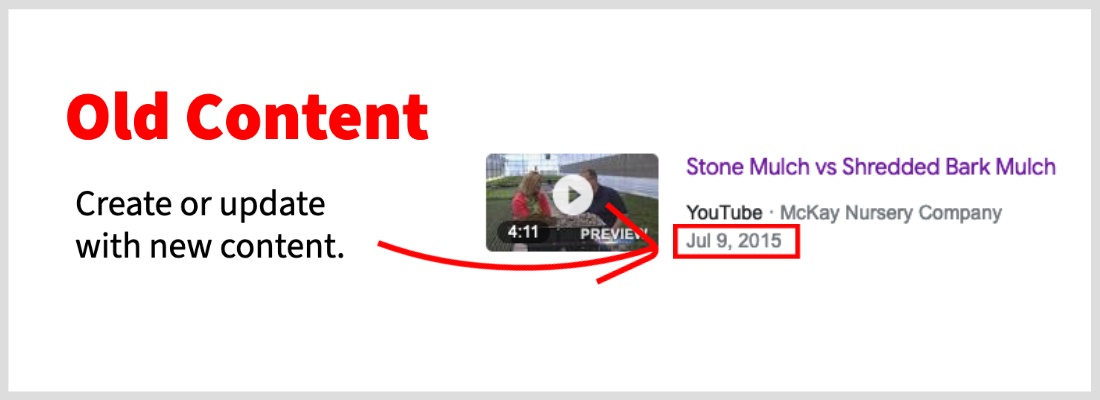
- Is the content on their website easy to understand?
- Do they have pictures and examples?
- Do they have a blog?
- What's the word count of each blog post?
- Is it quality information, or you've read it somewhere else before?
- Do they describe their local services in great detail, or is it thin and generic information?
- Is there something missing on their website that you can add?
- Are there questions people are asking that your competitors don't answer?
Find content gaps and fill them.
Use these opportunities to show potential customers and search engines that your website and web pages are better and satisfy what searchers want.
4. Find Opportunities to Increase Conversions on Your Website
What is a conversion?
A conversion is when a website visitor does something you want them to do.
Like filling out a form for a quote, calling your business, or subscribing to one of your services.
Conversion rate optimization is about testing everything on your website to get more conversions.
Things you can test on your website to increase conversions include:
- Web page headlines
- Call-to-actions
- Form lengths
- Button colors
- Meta descriptions
- Title tags
- Adding videos
For example, you can test using fewer form fields on your "contact us" form.

Use clickable phone numbers.
Help make your visitors work less when trying to reach you.

Answer questions and address objections customers might have.
Include a FAQ section on each service page to address any objections potential customers might have.
Make finding your address, phone number, and other contact information easy.

Remove social media buttons from the top of your website. They are distractions that will kill your conversions.
When people click on them, they never come back.

Frequently check to make sure your website is secure.
Potential customers who visit your site may leave it when they see it is not secure.
If your site is not secure, clicking on the padlock next to your domain name will show this message.
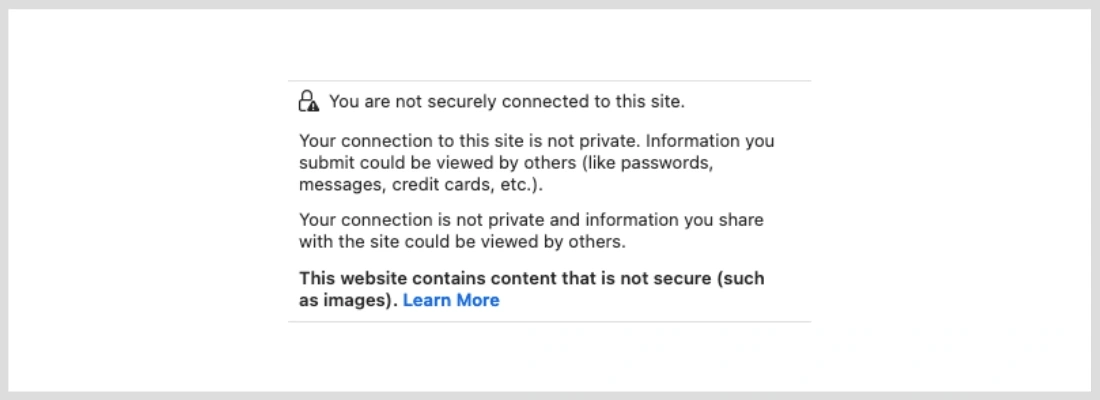
Write and re-write call-to-actions to see what works and what doesn't work.
Add different types of media to keep your visitors engaged.

Add video, audio, and infographics to keep your website visitors engaged.
Get on a podcast, create a video about mulch vs. stone, or create an infographic about
Use Google Analytics to see where users enter your website, how long they stay, and where they leave?
Use the Google search console to see what keywords people use to find your website.
Remove intrusive pop-ups that can frustrate some users (like me).
5. Finding Opportunities Your Competitors Haven't Noticed.
When doing keyword research, look for opportunities that your competitors are missing.

Look for keywords you can add to your website and add value to potential customers.
#3. Improve Existing Pages on Your Website
Improving pages on your site is also known as On-Page optimization or on-page SEO.
With on-page SEO, you find and fix the problems on your web pages.
Optimizing existing pages on your website can bring several benefits, including:
Improved search engine rankings:
Optimizing existing pages on your website can improve their relevance and quality, which can help them rank higher in search engine results pages (SERPs). This can increase the visibility of your website and attract more organic traffic.
Increased traffic and conversions:
When you optimize existing pages on your website, you can improve user experience, increasing their click-through rate (CTR) and attracting more traffic to your website. This, in turn, can lead to more conversions, such as sales, sign-ups, or downloads.
Better user experience:
Optimizing existing pages on your website can improve their layout, design, and content, enhancing the user experience and making it easier for users to find what they are looking for. This can improve engagement, reduce bounce rates, and increase the time spent on your website.
Cost-effectiveness:
Optimizing existing pages on your website can be more cost-effective than creating new pages from scratch. You can leverage your existing content, design, and layout to improve their relevance, quality, and user experience. This can save time and resources while delivering better results.
Competitive advantage:
Optimizing existing pages on your website can help you stay ahead of your competitors by providing more valuable and relevant content to your users. This can increase your website's authority, trustworthiness, and reputation, which can help you attract more traffic, backlinks, and social shares.
1. Look For and Fix Broken Links
Find and fix any broken internal and external links on your landscaping website.
Clicking on a broken link results in a 404 error, which presents a terrible user experience.
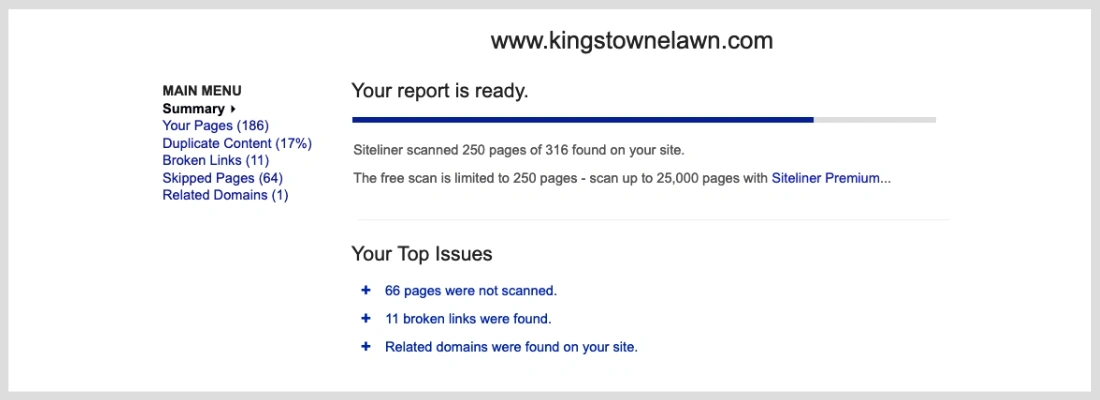
2. Use Keyword-Rich Title Tags and Meta Descriptions
Use keywords in the title tags and the meta description for each web page.
When you use keywords in your title tags and meta descriptions, you can help increase click-through rates to your website.

Your title tag is just HTML code that allows you to give your web page a title.
A meta description is a snippet of 170 characters that summarizes what a web page is about
3. Optimize Images on Your Website
Fix images on your landscaping website.
Some images on your website may be too large.
These large image files can slow your website, especially on mobile devices.
A slow website or web page is bad for your SEO and will negatively affect your website performance and your conversions.

You can use a free tool like Squoosh that can resize your images.
Squoosh can also change the image's web format to a more web-friendly format like webp instead of jpg, jpeg, or png.
Also, don't forget to add alt tags to your images.
Alt tags (or alt text) are HTML attributes used to describe the content of images or other media elements on a webpage.
The purpose of alt tags is to provide an alternative text description of the image that can be read by screen readers for visually impaired people or search engine bots.
Alt tags help improve SEO by providing search engines with a textual description of the image that can be used to rank the page in search results.
Also, it is important to use keywords in your alt text.
4. Add Fresh Content Regularly
Adding fresh content is an essential part of your SEO strategy.
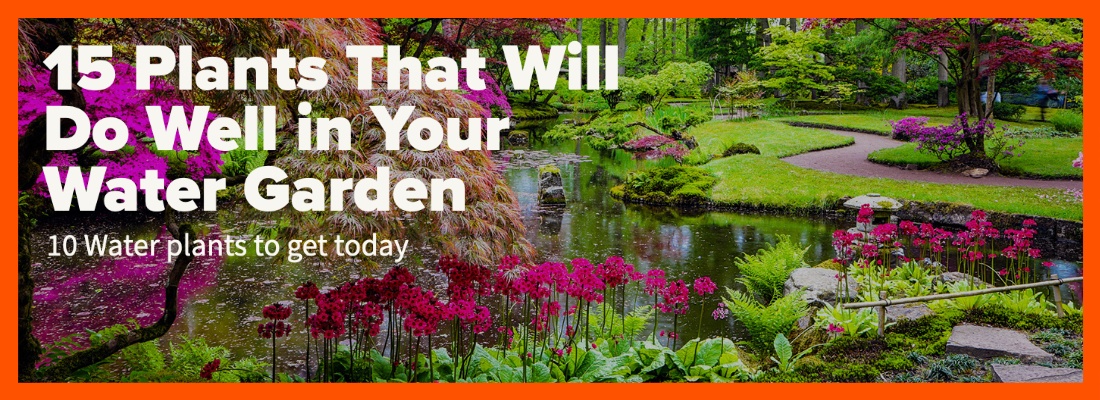
The more content you add, the more pages the search engines will have to index.
The more pages you index, the more of a landscaping expert you appear to the search engines and potential customers.
Adding new content to your website also keeps search engine spiders interested and crawling your website.
The benefit of search engine spiders coming back to crawl your website is that when you add new content, it will show up in days (or less) and not take weeks.
But don't just make content for search engines.
Make it for customers searching for your services.
5. Avoid Having Thin Content Web Pages
Thin content refers to web pages with low word count or poor content quality.
It can be harmful to SEO in a number of ways.
Thin content is copied from elsewhere and doesn't offer your potential customers any value.
When creating content, make sure it is fresh and offers your website visitors information they could use.
Below is an example of a thin content service page.
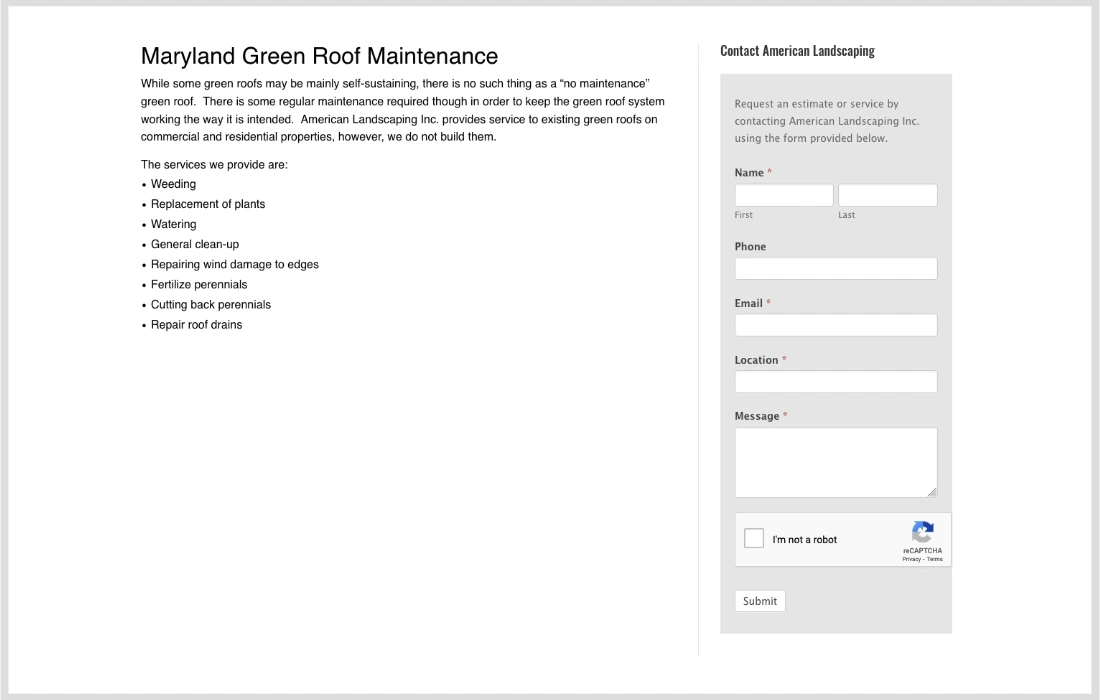
Thin content can affect your website in several ways:
- Poor user experience: Thin content can make your website look unprofessional and provide a poor user experience. Users may feel misled or frustrated when they land on a page that doesn't provide them with the information they were looking for.
- Lower search engine rankings: Search engines aim to provide users with the most relevant and high-quality results for their queries. Thin content is often seen as a low-quality signal. It can result in fewer visitors and less organic traffic to your website.
- Higher bounce rates: When users land on a page with thin content, they are more likely to leave your website quickly. This can lead to higher bounce rates, which can further hurt your SEO rankings and harm your website's credibility.
- Low social engagement: Thin content is less likely to be shared on social media platforms. This can result in lower social engagement, fewer backlinks, and less referral traffic.
6. Make sure you have a Mobile-Friendly Website
Today you must have a mobile-friendly website.
Why?
Because people expect it and because it is one of Google's 200 ranking factors for ranking websites.
Google's mobile-first indexing states that Google will index the mobile version of your website and use that for determining rank.
If you don't have a mobile-friendly website, you can rank lower in the search engines and expect fewer people to visit your site.
And low conversion rates.
7. Get Professional Help if You Need it
If you need help optimizing your landscaping company website, you can always seek help from an SEO specialist.
An SEO specialist will be better for your company if you don't have the time to do SEO for your business.
Need help with SEO for landscapers?.
Let's show you how search engine optimization can help your landscaping company grow.
8. Build Topical Authority and Be the Authority
Become the authority on everything landscaping and lawn care.
Always show that you are an expert by giving customers and search engines information that shows you are an expert.
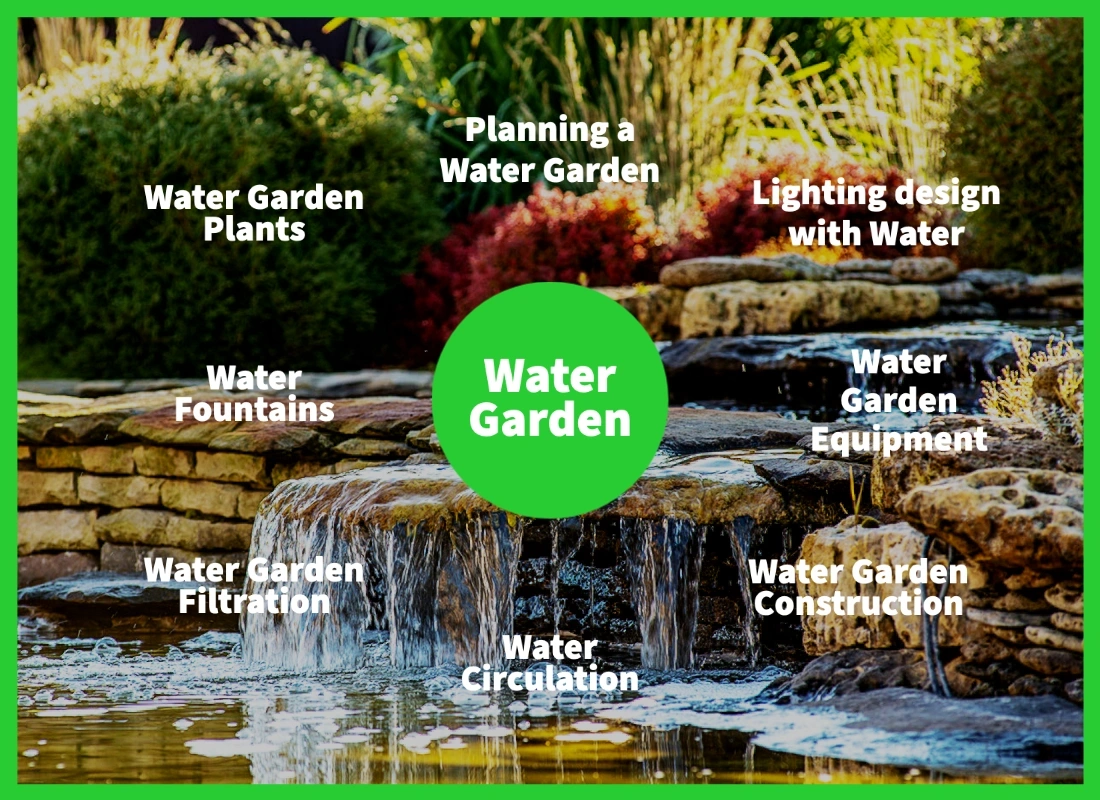
Write keyword-focused blog posts on what your landscaping company does, and give free high-quality information to people searching for your services.
Answer questions that you know potential customers are asking on your website.
Go in-depth on each service you provide.
If you build water gardens, create a content hub around water gardens.
#5 Link Building and Getting Backlinks
Link building is another crucial element for a successful SEO campaign.
It is the process of getting backlinks.

Backlinks are links from other websites pointing to your website.
It is also one of Google's main ranking factors.
It is so important that ranking on the first page without them will be hard.
But how can you get backlinks?
There are different sites you can get backlinks on.
Some sites include:
Angie's List
Houzz
Home Advisor
Next Door
patch.com
yelp.com
facebook.com
bbb.org
servicemagic.com
yellowpages.com
thumbtack.com
chamberofcommerce.com
You can also join local and national landscaping organizations like:
Landscape Contractors Association
You can also get backlinks by joining your local area Chamber of Commerce.
Another way to get backlinks is to create content people want to link to.
You can write content, create an infographic, be a guest on a podcast, and even create a video series.
Example.
What if you created a guide called "The Correct Way to Prune Your Plants."
Or what if you made a five-part video series on creating a brick driveway or a series on building an infinity-edge pool?
Would interested customers and bloggers link to this content?
#6 Get Involved in Your Community
If your landscaping company is local, you should get involved in your community.
Sponsor your local baseball team, football team, or any sports team.

Sponsoring teams or other organizations needing help shows that you are part of your community.
People in the area naturally want to do business with you instead of a company they know nothing about.
Also, participate in events or exhibitions in your local area.
#7 Claim, Optimize and Manage Your Google My Business Page
If you don't have a Google My Business page, get one.
As a business owner, your Google My Business page (Google Business profile) is one of the most critical elements for your local SEO.
Local SEO is the same as regular SEO but targets local customers in your area.
A Google Business Profile is like getting an extra website from Google.
The benefits of having your Google Business Profile are:
Increased visibility:
Your Google Business Profile can appear on Google Maps and Google search results, making it easier for potential customers to find your business
Better customer engagement:
You can respond to reviews, answer questions, and post updates directly from your Google Business Profile, which can help you engage with customers more effectively.
Enhanced credibility:
A complete and accurate Google Business Profile can help establish your business as trustworthy and professional in the eyes of potential customers.
Detailed insights:
Google provides insights on how customers interact with your business profile, including how many people view your profile, how they find you, and what actions they take, which can help you optimize your marketing efforts.
Improved search engine optimization (SEO):
Having a Google Business Profile can help improve your website's search engine rankings, as Google considers the information provided in your profile when determining the relevance of your business to search queries.
Access to Google My Business tools:
By creating a Google Business Profile, you can access a range of tools, including the ability to create posts, add photos, and create ads, all of which can help you better promote your business online.
Ability to attract more customers:
By using Google My Business features like Google Posts, you can create compelling content that can attract more customers to your business.
If you don't have the time to start or manage your Google Business Profile, check out our GMB management services.
#8 Always Ask for Reviews
Google and other search engines love customer reviews.
Reviews show search engines that people trust your business.
They also help improve your organic search rankings since they signal to search engines that your business is relevant and trustworthy.
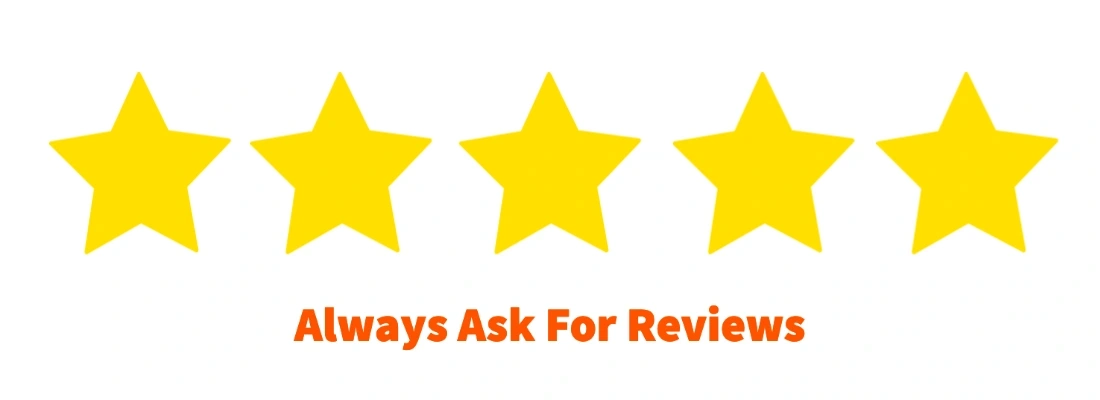
Reviews can boost your conversion rate by convincing potential customers that your business is worth their time and money.
Asking for reviews can also help build customer loyalty and word-of-mouth marketing for your business.
Finally, don't forget that customer reviews can provide valuable feedback about your landscaping services that you can use to improve.
How Do You Know if You Need Search Engine Optimization for Your Landscaping Business?
You'll know if your business needs SEO services if:
- You can't find your business website in the Google Local Pack or the organic search engine results when you search for your services. Look on the first page of the map pack and the first page results.
- You don't have any website traffic, or you don't know how many visitors come to your website every month.
- You don't get leads from your website.
- Other landscaping companies rank higher than you.
- You didn't do any keyword research or just guessed your keywords.
- You rely on Google Adwords and social media marketing to get customers.
- You depend heavily on referrals for business.
If you can say yes to any of the abovementioned issues, you can benefit by adding landscaping SEO to your digital marketing.
SEO for Landscapers in Maryland: So What Now?
What are you going to do?
The truth is your landscape companies have three choices:
- You can try to figure out how to do search engine optimization yourself.
- Work with an SEO company (and not worry about SEO).
- Do nothing and hope everything works out.
I recommend the second option and focus on what matters in your landscaping business:
Doing great work and making your customers happy.
So if you'd like us to help you get more leads and clients for your business, book a call.
Or, click here to get a free SEO audit and see what's holding your site back from ranking in the search engines.
No pressure.
Thanks for reading!

About the author
Kester is the Director of SEO at Bowie SEO. He has been doing SEO and digital marketing for more than 4 years. When not engulfed in SEO or building websites, you can find him with his family, riding his bike, or relaxing in front of his aquarium.